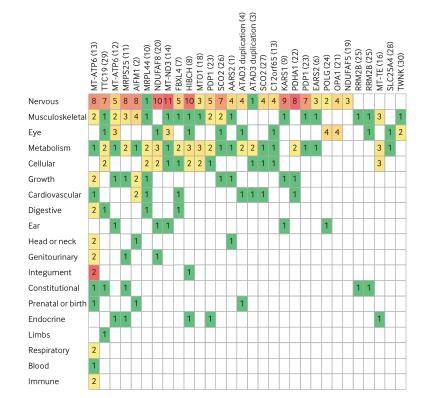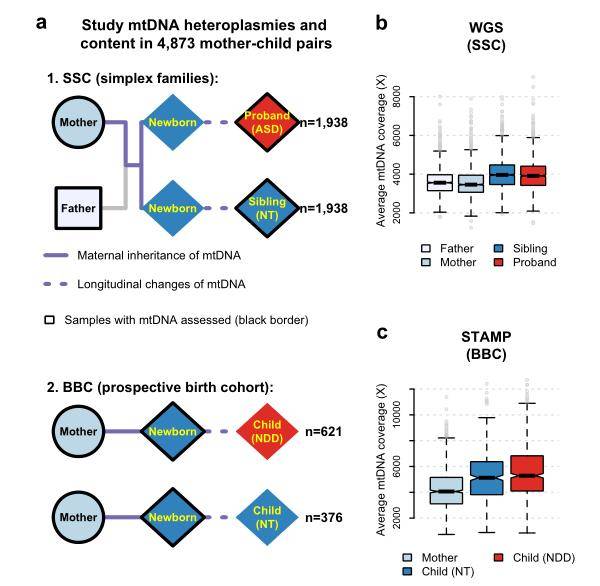Mitochondria are double-membraned organelles in cytoplasm of almost all eukaryotic cells. They play important roles in energy production, immune response, epigenetic regulation, apoptosis, and many other metabolic and signaling processes.
Mitochondrial disease is one of the most common genetic diseases, but about 40% of patients are unable to undergo genetic diagnosis, which limits genetics consultation and prevention. Whole genome sequencing (WGS) has the potential to shorten the "diagnostic odyssey" for patients with suspected mitochondrial disorders. The author studied 319 households with suspected mitochondrial diseases and conducted whole genome sequencing, with a total of 345 participants aged from 0 to 92 years old. The results indicated that a definite or probable genetic diagnosis was identified in 98/319 (31%) families, with an additional 6 (2%) possible diagnoses. A definite or probable genetic diagnosis was identified in 98/319 (31%) families, with an additional 6 (2%) possible diagnoses. Through different analyses, researchers found that they were able to make clear or possible genetic diagnoses for 98 families (31%). This study provides valuable new resources for the discovery of mitochondrial disease genes in the future, helping to discover new disease genes more quickly and accurately, and providing genetic diagnosis for more difficult to diagnose patients.
 Overview of analyses and sources of diagnoses.
Overview of analyses and sources of diagnoses.
 Human Phenotype Ontology (HPO) terms in patients with mitochondrial diagnoses.
Human Phenotype Ontology (HPO) terms in patients with mitochondrial diagnoses.
Mitochondrial Whole Genome Sequencing to Analyze the Pathogenic Mechanism of Genetic Diseases
Autism spectrum disorder (ASD) is an early onset complex neurodevelopmental disorder characterized by social communication disorders and repetitive stereotypical behavior. Mitochondria are essential for brain development and multiple studies have shown that defects in mitochondria in brain cells can lead to the occurrence of ASD. The researchers investigate the association of mtDNA heteroplasmies (co-existence of mutated and unmutated mtDNA) and content with ASD, as well as its inter-generational transmission and sex differences among two independent samples: a family-based study (n = 1,938 families with parents, probands and sibling controls) and a prospective birth cohort (n = 997 mother-child pairs). The author found for the first time through mitochondrial genome sequencing that compared to unaffected siblings, ASD probands carry higher pathogenicity of mitochondrial heterogeneity but lower mitochondrial copy numbers. Interestingly, the author believes that increasing mitochondrial copy numbers may partially alleviate the pathogenic effects brought about by mitochondrial heterogeneity. This study also proves that the older the mother gives birth, the more mitochondrial heterogeneity may accumulate in the offspring, and the higher the pathogenicity of these mitochondrial heterogeneity. This evidence further supports previous studies that female late childbirth may increase the risk of ASD in the offspring. In addition, research has shown that inheriting more mtDNA PP heterogeneity only significantly increases the risk of ASD in male offspring, indicating that women are more tolerant to mtDNA PP heterogeneity compared to men. This result further supports the phenomenon that male patients with ASD have a higher proportion than female patients in clinical practice. In summary, this study investigated the important roles of mitochondrial copy number levels and mitochondrial heterogeneity mutations in the occurrence and phenotype of ASD through a large sample population queue and ultra deep mitochondrial genome sequencing, indicating the important role of mitochondrial functional changes in the occurrence and development of ASD, and providing new ideas for revealing the genetic pathogenesis of ASD and theoretical guidance for the development of diagnostic techniques and novel therapies based on mitochondrial genomes.
 Study design and mtDNA evaluation in the SSC and BBC
Study design and mtDNA evaluation in the SSC and BBC
Mitochondrial genome sequencing is a useful diagnostic test in patients with suspected mitochondrial disorders, it will be an effective method for diagnosing mitochondrial diseases in the future. We firmly believe that it will reveal more about the pathogenesis of genetic diseases for us.
References:
- Guo, Xiaoxian et al. "High-frequency and functional mitochondrial DNA mutations at the single-cell level." Proceedings of the National Academy of Sciences of the United States of America 120 (2022): n. pag.
- Wang, Yiqin et al. "Association of mitochondrial DNA content, heteroplasmies and inter-generational transmission with autism." Nature communications vol. 13,1 3790. 1 Jul. 2022.
- Schon, Katherine R et al. "Use of whole genome sequencing to determine genetic basis of suspected mitochondrial disorders: cohort study." BMJ (Clinical research ed.) vol. 375 e066288. 3 Nov. 2021.
For research purposes only, not intended for clinical diagnosis, treatment, or individual health assessments.


 Sample Submission Guidelines
Sample Submission Guidelines
 Overview of analyses and sources of diagnoses.
Overview of analyses and sources of diagnoses. Human Phenotype Ontology (HPO) terms in patients with mitochondrial diagnoses.
Human Phenotype Ontology (HPO) terms in patients with mitochondrial diagnoses. Study design and mtDNA evaluation in the SSC and BBC
Study design and mtDNA evaluation in the SSC and BBC